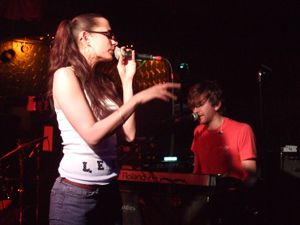Arts & Culture
Talking Heads
Angela Iannone in Talking Heads Alan Bennett’s Talking Heads, a series of six monologues, was so succesful in its incarnation on BBC television that it is living another life in live theatre. Milwaukee Chamber Theatre brings these monologues to the stage in two alternating programs at the Broadway Theatre’s main stage this month. The show opened with a performance of Series A — the all female show. In the first monologue, set in sparse domesticity suggestive of the mid-1980s, attractive actress Lesley (Wendy Bazar) relates landing a marginal role in a marginal film solely because of her physical attributes. It’s a clever bit of comedy revealing the true depth lying dormant in a woman who seems to be genuinely shallow, and what Bazar lacks in presentation (her accent, presumably meant to be British, wavered somewhere between that, Scottish and Irish, and occasionally Southern) she makes up for with a charming presence that nearly carries the monologue. The second monologue in Series A, “A Lady Of Letters,” features Raeleen McMillion as a lonely old woman named Irene whose civic-mindedness has reached obsessive levels. She’s writing letters to public officials about every conceivable inefficiency and flaw and casting a concerned eye toward house of the young couple that has moved in next door. McMillion carries Bennett’s repetitious monologue with a captivating performance that easily pulls the show through to intermission. Still, it is unfortunate that Bennett stretched this one out longer than it deserved. Certain plot points are repeated in an apparent attempt to pad out the monologue, and while the character is interesting, Bennett does not delve into her personality enough to keep the monologue fresh for its complete cycle onstage. The show returns after intermission with Angela Iannone in “Bed Among the Lentils.” Iannone, who has shown considerable talent for monologue, plays Susan, a vicar’s wife. Strikingly articulate, Susan is recognized solely for her status and otherwise rarely gets any attention. Here she speaks to the audience in clear stream of consciousness, relishing the opportunity to speak about whatever she wants. Iannone seems to enjoy the role a great deal, delivering Bennett’s humor with soulfully precise comic timing. A particularly busy weekend for openings didn’t allow for review of Series B, which includes performances by Laurie Birmingham, Norman Moses and Milwaukee Chamber co-founder Ruth Schudson. VS Milwaukee Chamber Theatre’s production of Talking Heads runs through November 4 at the Broadway Theatre Center’s Cabot Theatre. Tickets can be purchased in advance by calling the box office at 414-298-7800 or online at www.chamber-theatre.com.
Oct 23rd, 2007 by Vital ArchivesSITE unveils Fall 2007 installations
Much of Milwaukee’s art revival is concentrated in the condo-ready Third Ward, so it seems a brave feat that a two-block stretch – beginning at the struggling, yet bustling 3500 block of West North Avenue – is seeing a revival of its own. It’s strange and wonderful to see art and vitality on an arterial street that doesn’t share the business or attention of its East Side and Wauwatosa bookends and this installation, organized by IN:SITE, purveyors of public art, features artists Laura Gorzek, Chris Murphy and Kasia Drake. The untitled exhibit opened on October 27, and each of the three installation promises to provoke and inspire. “The thing about public art that I don’t always like is when it advocates a certain point of view,” says Laura Gorzek, a photography-based artist currently attending UWM. “I’d like to keep it more open-ended … letting [viewers] draw from their own experiences, their own level of dealing with something.” Gorzek’s piece, Surface v. Secret, incorporates elements of her photographic works on four vinyl-constructed banners across a large 8-by-24 foot billboard at 3615 W. North Ave. With her artwork she hopes to address women’s identities and self-perception – what is apparent and what lies hidden. Each piece demands multiple viewings to grasp the complex, layered narrative thread. “I thought it would be interesting to try this – most of what I do is more intimate and private. So juxtaposing this to a public space, it’s like making private life more universal,” says Gorzek. Chris Murphy’s piece, Choros, has been gestating for awhile. Murphy watched day after day since last summer as stories of Milwaukee’s homicides racked up on the news. “Someone else is shot again. I mean, I lived in Oakland, California and it didn’t seem this bad,” says Murphy – a master electrician, artist and father. “I’m a very 3-D person, and I thought about ways to put a face on it.” Choros – Greek for the chorus of masked players in tragic plays who offer background or commentary – is composed of scores of semi-translucent masks molded from the faces of real volunteer subjects. The gauzy masks, made of quick-drying water-based resins, are mounted on a maroon backdrop at 3611 W. North Avenue, each lit from behind by LEDs. They represent each person killed by gunshots in the city this year. At night the sculpture takes on an ethereal quality. “I just want to have [the viewer] acknowledge it as a first step,” says Murphy. “I want to humanize the whole thing instead of victims being a whole number. These people are not going to show up to the dinner table – they’re gone.” The final project, by fabric artist Kasia Drake and 11 collaborators, continues the international You Are Beautiful campaign started by anonymous artists in Chicago. It is installed in the long-standing Milwaukee Paint Store windows at 3532 W. North Avenue. YAB’s mission is to “reach beyond ourselves as individuals to make a difference by creating moments of positive […]
Oct 22nd, 2007 by Brian JacobsonThe Woman in Black
Renaissance Theaterworks revives the classic art of scary storytelling with Stephen Mallatratt’s wildly successful The Woman In Black. Based on the novel by Susan Hill, The Woman In Black tells the story of a man trying to escape ghostly events his past that have haunted him for years. The play, one of the longest-running productions in the history of London theatre, comes to the stage of the Broadway Theatre Center’s Studio Theatre in a remarkably well-balanced Renaissance production. Milwaukee Rep resident actor Jonathan Gillard Daly plays a London solicitor who seeks to deal with traumatic events from his past by performing a staged reading of his recollections. Unskilled in the art of public performance, the solicitor enlists the help of a charismatic young stage actor named Arthur Kipps (Bran J. Gill.) As Kipps consults with the solicitor in an empty theatre, the story takes on a life of its own. As an actress, Mary MacDonald Kerr has proven her ability to bring drama (Burn This) and comedy (String of Pearls) to the stage vividly and with grace. In directing The Woman In Black she has put together a spook story with enough startling moments to keep an audience interested from beginning to end. Kerr makes clever staging decisions in the reasonable intimacy of the studio theatre. With the aid of ubiquitous lighting guy Jonathan Fassl, Kerr draws a moody atmosphere of light, shadow and darkness around a classic ghost story featuring two talented actors and a pair of equally talented shadows. Daly’s real challenge here seems to be the art of pretending he knows nothing about theatre as his character. It’s strange to see a man with Daly’s extensive stage experience pretending to be theatrically challenged. Daly presents his character as a man taking a liking to telling the story in a full theatrical production complete with recorded sound effects. The darkness of his tragic memories is barely on the edge of his consciousness as he delves deeper and deeper into the past. Gill’s stage charisma sells the role of actor quite well. The character becomes more complex as the story starts to develop its own momentum, but Gill manages a reserved sense of fright as he is immersed in the solicitor’s memories. Rebecca Phillips and Emily Trask round out the cast as shadowy figures. The most impressive part of their performances here is what isn’t seen onstage. Thanks to stage tricks, they’re maneuvering around in what must be something very close to total darkness to strike the perfect pose as the lights suddenly flash to reveal them. As often as this happens, it never ceases to be a shock. Renaissance Theaterworks’ production of The Woman In Black runs through November 4 at the Broadway Theatre Center’s Studio Theatre. Tickets can be purchased in advance by calling the box office at 414-291-7800 or online at www.r-t-w.com.
Oct 19th, 2007 by Russ BickerstaffThe Wonder Bread Years
Stand-up comedian/writer/commercial spokesman Pat Hazell is touring the country with The Wonder Bread Years, a series of recollections about growing-up as a baby boomer. Local comedian and theatre icon John McGivern takes Hazell’s role in Milwaukee’s production of the one-man show. The set is a stylized suburban front porch, personalized with a few McGivern touches to ground us in 1960s Milwaukee. From tiny kid’s cereal boxes to Kool-Aid and Toughskin jeans, the monologue about childhood in America covers a lot of common pop cultural ground, and anyone who grew up in the US in the 60s, 70s or 80s can make a connection with Wonder Bread Years. Pat Hazell’s performance of the same material was aired some time ago as a one-hour PBS special. Even though Hazell performed his own material, McGivern’s performance far outshines Hazell’s. Hazell’s delivery is heavily rooted in stand-up comedy, while McGivern, whose experience is richer in the theatrical stage, performs with a much more engaging stage presence. When McGivern is onstage, he’s there for far more than telling jokes. He genuinely loves being there. The delivery may feel a little over-enthusiastic in places, but McGivern’s trademark exuberant earnestness makes the material feel much more organic. This is particularly effective when the comedy settles down in poignant observations about the nature of childhood. Hazell’s delivery is detached — like he’s delivering a sales pitch. When Hazell gets serious and sentimental with his own material, it comes across like a speech at a $300 per ticket motivational seminar. When McGivern delivers the same material, is performance caries the kind of authentic ebullience that makes it work. McGivern may be better with The Wonder Bead Years than its original author was, but in places it is clear that McGivern isn’t entirely comfortable with Hazell’s material. When McGivern is performing his own material, there’s a kind of magic onstage – especially in his interactions with the audience. It’s a distinct theatrical experience when a stage presence as strong and dynamic as McGivern talks about his childhood to a packed audience of people who could’ve been in the area when he was growing up. Everyone’s in a theatre, but there’s that distinct feeling that you’re hanging out with a nice guy from the neighborhood on his porch on the east side. VS Pat Hazelton’s The Wonder Bread Years with John McGivern runs through October 28th at the Marcus Center for the Performing Arts. Tickets can be purchased in advance by calling the Marcus Center at 414-273-7206 or online at www.marcuscenter.org
Oct 12th, 2007 by Russ BickerstaffEvery Picture Tells a Story
In becoming a photographer, one makes a choice to be the teller of stories rather than the subject, witness to the deeds of others, a visual historian to a particular moment in time Milwaukee photographer Jim Herrington has stories of his own, of course, but what fascinates is his body of work – and that’s the way he wants it. He has a gift for capturing the essence of his subjects, preferring native settings over studios and just shooting until he captures that perfect moment. “It’s like writing a song. Sometimes it’s there from the beginning and you have to get out of the way and let it happen.” To peruse Herrington’s portfolio is particularly delightful for lovers of American music. There’s almost nobody he hasn’t shot, and he has stories to tell about the rest. He also climbs and has incredible pictures, not so much of mountains, but of mountaineers. Something of a dreamer himself, he gravitates towards others like him, recording their visages for posterity and his own collection. Herrington will show work on Gallery Night at Cedar Gallery, upstairs at 326 N. Water St. But what you won’t get on October 19 is a sense of the stories he’s amassed along the way; how his photos came to be, a sense of the person behind each still image. Some of those stories are told here, in his words; a few others are on his website at jimherrington.com. The rest are his own – as it should be. VS
Oct 12th, 2007 by Vital ArchivesHA!
In Tandem Theatre Company marks their 10th Anniversary with the Midwest premiere of HA! Along with this premiere, the company also debuts their permanent residence at Tenth Street Theater, a few steps underground below a red brick church on Wisconsin Avenue near Marquette University. By opening weekend, In Tandem had finally received temporary occupancy. But even with unfinished features, the high ceilings, cathedral arched doorways and comfortable in-the-round theater will certainly provide the now-established troupe with an elegant space enabling their mission to enlighten, inspire, provoke, and entertain. Rich Orloff’s HA! pursues these themes with three distinctly different yet connected acts of theater. As a playwright, Orloff has won multiple awards for his comedies, and was most recently honored with a 2003 Dramatists Guild Fellowship. This particular play represents his comedic timing, but with biting “a-ha” moments. The first act sets a scene in ancient Greece, with the court of King Oedipus putting a politically correct spin on this unusual crisis in leadership. Act II moves to January 5, 1905, “when the snow in Russia turned red,” looking at this violent act from several points of view including the Russian aristocracy and their servants. The third act develops in a classroom, as a young student attempts to defend his ‘Master of Universe’ degree by designing a complete ecosystem named Earth. Its supreme element, the human being, is called before his professors, who will give him his final grade. At first impression, the entire play appears to be an extended riff on Saturday Night Live, but beneath the humorous lines are buried truths and thoughts worth contemplating. The cast, playing multiple roles, inclues actors Parker Drew, Simon Jon Provan, Kevin Rich and Jacque Troy as well as supporting cast members Jack Lee and Michelle Waide, and together they carry the comedy well. Under Chris Flieller’s direction, time and thought is given both to both laughter and the more controversial subject material. In two hours, HA! creates smiles but also plenty of conversation afterwards if the audience is willing. Several characters offer humorous “insight into the human condition,” asking “why human beings, given all the recipes and resources for paradise, were deemed impractical but at least biodegradable?” This series of comedic moments inspires and provokes, presenting a thoroughly happy 10th Anniversary for In Tandem. Celebrating in their new home on Tenth Street, HA! continues their theater traditions with wit and style. In Tandem Theatre Company continues presentingHA!through October 21 at Tenth Street Theater, 628 North Tenth Street, Milwaukee. For information: 414.271.1371.
Oct 10th, 2007 by Peggy Sue DuniganFINAL WEEK!
By Tracy Doyle Windfall Theatre’s latest venture is a bold attempt at staging a very intriguing and challenging piece of drama, David Mamet’s Cryptogram. Mamet’s work, famous for its frequent interruptions, trail-offs and swear words, is often difficult to nail, but Windfall comes close with this production. And although some of the clues in this play of mystery may be misguided, overall the experience is highly engaging and worth the effort. The definition of a cryptogram (according to the Merriam-Webster Dictionary) is a communication in cipher or code, and that is exactly what to expect from Cryptogram. Words, props, set pieces, even gestures are all part of the code, and you, as an audience member, need to piece together the clues to figure out what is going on. The play revolves around the strangely absent Bobby (who never appears), his wife Donny (Carol Zippel) and their pre-adolescent son John (Avi Borouchoff), who is set to go on a camping trip with his father. As time passes and Bobby’s absence continues, the situation becomes more and more absurd: secrets are revealed and John drifts further and further toward a strange mental place children should never go, due in part to his insomnia and in another part to his role in the adults’ affairs. John starts questioning everything from the existence of countries on the globe to whether or not his mother has ever wanted to die and eventually brings the play to its surreal ending. The character development is outstanding with Larry Birkett as the family’s bachelor friend, Del, displaying an unsettling, quiet passion. Borouchoff shines with talent rarely seen in young actors, while Zippel’s struggle as her life comes crashing down around her is amazing to watch. However, the pacing was off at times, especially in the first scene, and the blocking left much to be desired. Misdirection of some of the key clues may lead audience members to incorrect conclusions, but all in all, this is a difficult yet fun piece not to be missed. Cryptogram continues though October 13 at Village Church Arts, 130 E. Juneau Avenue in Milwaukee. For tickets call 414-332-3963.
Oct 8th, 2007 by Vital ArchivesMartin Ramirez at MAM
Martin Ramirez is an enigma. For decades, he was classified as one of the three greatest “outsider” artists of contemporary American art, but next to nothing was known about him. In the last ten years, two dedicated biographers have beaten back the darkness surrounding the facts of Ramirez’s life, but this endeavor has lead to other questions. Ramirez was born in the Jalisco region of Mexico in 1895. In 1925, like many others — then and now — he immigrated to the United States to find work. He worked on the railroad in Northern California for five years, sending money home to his wife and four children in Mexico. In 1930, Ramirez was arrested for erratic public behavior, and ultimately institutionalized, first in Stockton and then Dewitt State Hospital. He was diagnosed with schizophrenia, and lived the rest of his life in the institution, where he died in 1963. Most of these facts were not known when Ramirez was categorized as an outsider artist in the 1970s. It was thought he might have been born in Mexico, it was thought he might have died in the 1960s. It was widely thought that he was a deaf-mute, which is not accurate. The term “outsider artist” was coined to denote an artist that did not take part in the “art world” — one that did not exhibit, did not invite or assimilate criticism, did not discuss their art. An outsider artist might be thought of as someone who refused or was unable to think of themselves as an artist. However, along with basic biographical details of Martin Ramirez’s life, we have learned in recent years that he did exhibit during his lifetime. A professor at Sacramento State College visited Ramirez often and arranged for his art to be shown, both in solo exhibitions and as part of group shows, on both coasts. Ramirez was critiqued. He had visitors in Dewitt that came to see him to discuss his art. One must wonder if Ramirez did think of himself as an artist, especially towards the end of his life. All he had was the hospital, and his drawings. All historical considerations and controversies aside, though, it cannot be denied that Ramirez had a vision of some sort. He was driven to create, whether or not he was an “artist” in classical terms. His drawings, on bits of paper pieced together with a glue made of potato and his own saliva, in crayon and colored pencils and whatever else the staff of the hospital had lying around, have a decidedly dreamlike quality. Viewing them, one enters a surreal realm of horses and trains and women wearing crowns. Everything is stylized, and it’s unclear how much of that is due to the fact that Ramirez was drawing from memory after being in an institution for 30 years, and how much of that is due to his schizophrenia. My favorite of his general themes are the trains and tunnels. He does variations; there are a few […]
Oct 5th, 2007 by Ryan FindleyElement Everest
By Kenya Evans Life is a Heist tells the spiraling stories of the hood rich just trying to get by and delivers a verbal vengeance signed and sealed by Ms. Everest personally. The first and only lady of local hip hop group Black Elephant – 2006 WAMI runners-up for best unsigned artist – Element Everest (yes, her real name) is debuting her first solo album. She’s no stranger to MCing, writing rhymes and shutting down naysayers who criticize or question her authority as a female rap artist. Gritty and unapologetic, Life is a Heist booms with 808s, snares and brassy beats against Element’s smoky voice. The up-tempo “Intro” has the layered instrumentals of a marching band, dramatic and charged with musical action. “Good Girls,” the first single, which premiered on local radio station V100, is a sexy and sassy boy-meets-girl love song that’s mellow and made to groove to. Element upholds what Black Elephant does best – telling tales of the city, from grinding streets to head-bobbing beats – but brings a bit more soul to her own songs. Element sings a cappella on “The Wire,” reminiscent of an old Negro spiritual, channeling the stark realities of modern-day urban strife and the continuous struggle of black life: that there’s no difference between slaving in the fields to becoming slaves of the mind and products of an impoverished environment. “Katrina,” a duet with local guitarist/singer/songwriter Evan Christian, speaks for the dismal and discriminated New Orleans natives who were victims of a natural disaster and their own government. Overall, it’s rich and hard-hitting, both lyrically and musically: Element doesn’t play nice. Get ready to take a bite out of some ghetto melodies that bite back.
Oct 4th, 2007 by Vital ArchivesAn Interview with Paul Robeson
By Jill Gilmer Interviewer: “Why did you stop making films?” Paul Robeson: “Because little Negro girls go to the movies looking forward to experiencing fantasy. But when they come home, they feverishly try to rub the color off of their skin.” The excerpt above is one of the provocative question & answer segments from An Interview with Paul Robeson. The Next Act Theatre opens its season with this probing drama about the legendary African American scholar, entertainer and political activist. The play, written by John Kishline and Paul Mabon Sr., with Mabon starring in the title role, examines Robeson’s life and legacy through a lively discourse between him and a New York Times reporter. Paul Robeson appeared in 12 films and stole the show in the musical Showboat with his soulful rendering of “Ole Man River.” In 1943, he achieved critical acclaim playing Othello in Broadway’s longest running Shakespearean play. Prior to establishing himself as a performer, Robeson led a distinguished academic career. He overcame overt racism and physical abuse to graduate as valedictorian of his class from Rutgers University in 1918, the third black student to attend that institution. In his spare time on campus, he earned 15 athletic letters in football, basketball, baseball and track. He went on to graduate from Columbia Law School. Beyond this string of accolades, Robeson is well-known for using his celebrity to draw attention to social and political issues. He criticized the racial stereotypes that permeated American media during the Jim Crow era and challenged the idea that black people should fight to defend a country that denies them many of the privileges of citizenship. Robeson defended his provocative beliefs with personal sacrifice. He stopped making films that perpetuated racial stereotypes. He announced that, for two years, he would only perform songs about social justice. Robeson’s actions are sometimes credited with jump-starting the Civil Rights movement. Robeson was also a target of the McCarthy era investigations. On several occasions, he visited the Soviet Union and found it a warm and welcoming nation. For urging peace with the Soviet Union and his outspoken views about race in the U.S., the House Committee on Un-American Activities blacklisted his films and recordings for eight years. They also revoked his passport, limiting his opportunity to perform in Europe, where he had his strongest following. Today, it is still difficult to obtain copies of Robeson’s work. The play’s strength is its examination of Robeson’s childhood and early adult years and his contributions to the intellectual debate about fascism and the interplay between class, race and power. Director David Cecsarini creates an ideal venue for showcasing Robeson’s ideas and talent with a minimalist cast and set in the intimate Off-Broadway theatre. Paul Mabon embodies the strength of Robeson’s intellect and character. His rich, bass voice brings a stirring authenticity to Robeson’s most memorable songs, including “Ole Man River.” The playwrights do a commendable job shining a light on Robeson’s ideas while holding the audience’s attention with the drama of […]
Oct 3rd, 2007 by Vital ArchivesThe Big Dig
“It swings between passion and obsession, constantly. It’s definitely at the point where I’m like, ‘do I want to buy groceries this week, or do I want to go digging in Indianapolis?’” Aaron Soma spends 12 to 16 hours a week, on average, digging for vinyl. At least once a month, he leaves the state to rummage through basements and backrooms for dusty jewels of sound. He calls it the “great nerd odyssey” – and he’s not being flip, despite the shadow of cool that has settled on record culture in recent years. Aaron can describe what he’s into – Northern soul, forgotten originals of ‘80s pop songs – but it’s hard to put a finger on what he’s really searching for. So in consideration of the question, he made a list, went to some record shops, and thought about it for a while. Here are four things he managed to sort out. 1. Covers, or forgotten originals of songs that were covered and became hits Aaron’s first digs were through his parent’s formidable collection of records. “I picked up Beatles albums,” he says, “wondering, looking at the records, noticing that the song wasn’t written by John Lennon or Paul McCartney, but some American R&B artist somewhere.” “That’s the really exciting thing about collecting,” says Andy Noble, co-owner of LotusLand Records. “You’re always following a path, and you’re probably following multiple paths.” “It could take you back to the beginning of recorded time – or to Africa, or to Brazil – just by following the sound, the producer, the people who were thanked in the liner notes, weird stuff like that. It’s an exploration.” Aaron is always learning; every dig is a research project. “I’ll bring a battery-powered portable record player with me to a shop and just dig through, set stuff aside. That’s how I teach myself what’s going on. I hardly ever know what I’m looking for when I go out: it’s really a dive into the unknown.” 2. Midwestern music Aaron’s serious collecting started with ‘60s psychedelic rock, especially local acts – Michael and the Messengers, The Illusion, The Legends. For the past two or three years, he’s been collecting mainly funk and soul music, and still turns up a lot of local material. “Because I dig regionally, I tend to come up with a decent amount of stuff that was actually happening here – Harvey Scales and the Seven Sounds, The Esquires.” On a sunny late-summer afternoon, Aaron drives me out to an empty storefront on North Avenue. Audie’s Records has been closed since the late ‘80s, and judging from the steamrollers parked next door, it might not be standing for much longer. It used to be a major distribution hub for hip hop, soul and funk in the Midwest. “A lot of that stuff is still here. In bigger Midwest cities – St. Louis, Detroit, Minneapolis – a lot of the shops get really picked through.” Still, good finds don’t come easy – especially with […]
Oct 1st, 2007 by Amy ElliottBuffalo
Affordable drinks and public smoking are two things homesick MC Lunaversol9, recent San Francisco implant, misses most about Milwaukee. Another is, of course, the people—not limited to her newfound friend and cohort Nicholas Sanborn. Sanborn, who frequented the coffeehouse where Luna worked, was familiar with her background with local hip-hop mainstays Def Harmonic, and presented her with an instrumental track in need of her flair. Though unable to produce anything for months, Luna eventually found the words, and the results were “Curtains,” a song about loss that would become one of her favorites to perform solo. “Deer Tracks,” where Luna’s smoke-ridden voice begs “I want antlers” the way a spoiled child demands her own golden goose, began as a looped guitar sample and was presented by Sanborn and verbally delivered by Luna in a similar fashion. “It was strange,” she says. “Unlike any other track I had ever been given. But gorgeous.” After two personally challenging and fulfilling songs, not committing to a project with Sanborn would have been foolish. At Sanborn’s request, the two formed Buffalo; Luna covers most of the lyrics, singing, and rapping, while Sanborn lays down the Wurlitzer, organ, piano, bass, guitar, and computer. “He is a musical genius, and I am mainly just a writer,” Luna admits. “There is really nothing he cannot do; his arrangements and choices are baffling. I only write when I can, and hope it fits.” Her unpretentiously earthy, soul-sopped attitude also bleeds out of her lyrics: “Is there a way to be a writer/And still be in love? Is there a way to drown in water/While watching it from above?” A short-lived, albeit intense fling last summer—evidence to support Luna’s rhetorical questions—was inspiration for the lion’s share of Buffalo’s first album. The debut has been recorded and is currently being mixed, but has no due date. While creative undergoings are usually compared to one’s children, Luna says music has always been more like a parent, much like the city she left to pursue life on the West Coast, a choice partner Sanborn respects and understands. Her goals for Buffalo, even after migrating from the Great Plains, are simply “to continue.” She adds, “to tour would be paradise.” Inspired by Fiona Apple, Tom Waits, Cocorosie, and David Byrne, among others, Luna has her eyes toward indie trip-hops TV On The Radio for tourmates. On March 3, 2007, the newly born Buffalo was unveiled to an audience. Live, the band is a different animal, when a drummer and an additional multi-instrumentalist fill out the stage. Despite Buffalo’s infancy, Luna has rapped since 1999 and Sanborn has played keys for Decibully since 2003, tallying volumes of stage and touring experience. The next Buffalo show, slated for her October Milwaukee homecoming, is promised to provide precisely “what you need at the time.” Luna’s own first impressions of Buffalo—strange and gorgeous—are likely to be yours, too. Two tracks are available for listen at http://www.myspace.com/iwantantlers
Oct 1st, 2007 by Amber Herzog




















